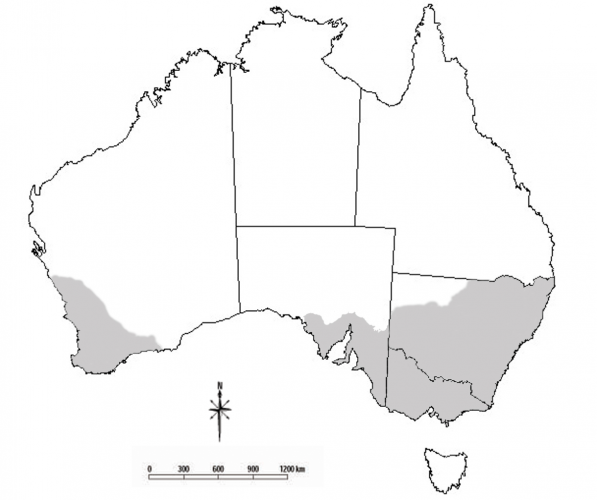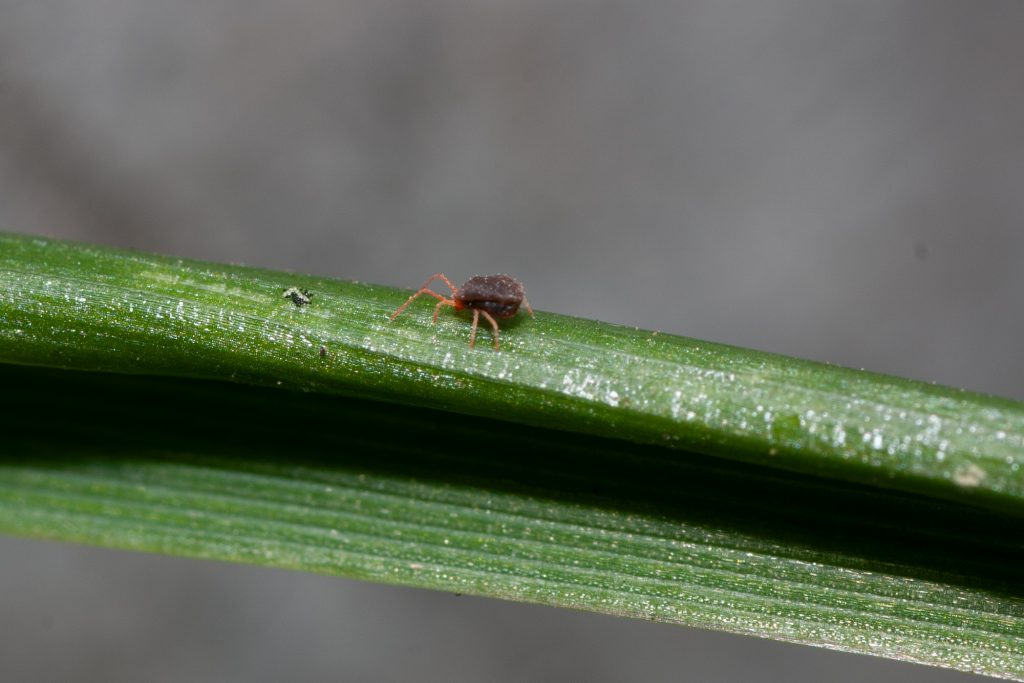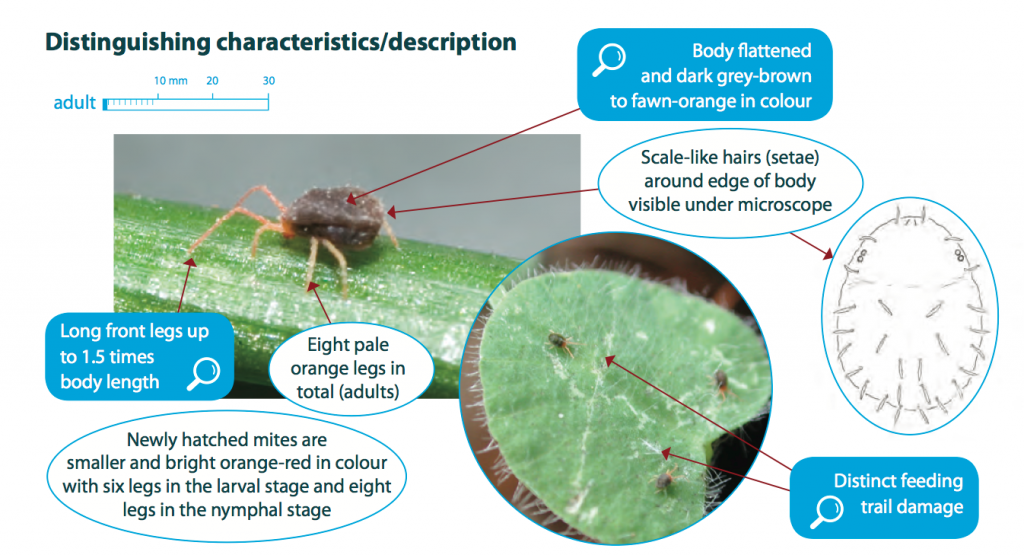Bryobia mite
Bryobia spp.
Other common names
Clover mite

Photo by Julia Severi, Cesar Australia
Summary Top
There are over 100 species of Bryobia mite worldwide, with at least seven found in Australian cropping environments. Unlike other broadacre mite species, which are typically active from autumn to spring, Bryobia mites prefer the warmer months of the year. Bryobia mites are smaller than other commonly occurring pest mites. They attack pastures and numerous winter crops earlier in the season.
Occurrence Top
Bryobia mites (sometimes referred to as clover mites) are sporadic pests typically found in warmer months of the year, from spring through to autumn. They are unlikely to be a problem over winter, however, they can persist throughout all months of the year. They are broadly distributed throughout most agricultural regions in southern Australia with a Mediterranean-type climate, including Western Australia, Victoria, New South Wales and South Australia. They have also been recorded in Tasmania and Queensland.

Description Top
There are at least seven species of Bryobia mites found in broadacre crops in Australia. These appear very similar. Bryobia mites are smaller than other commonly occurring pest mites, although they reach no more than about 0.75 mm in length as adults. They have an oval shaped, dorsally flattened body that is dark grey, pale orange or olive in colour and have eight pale red/orange legs. The front pair of legs is much larger; approximately 1.5 times their body length. If seen under a microscope, they have a sparsely distributed set of broad, spade-like hairs, appearing like white flecks (see Figure).
Accurate identification of mite species is important because management is species specific.


Lifecycle Top
Bryobia mites can have several generations per year, with mites being most active during periods when temperatures are above 10°C. Overwintering eggs hatch in spring when conditions become warm and dry. Hatched nymphs are small with bright red bodies and pale orange-coloured legs. They look similar to Balaustium mite nymphs.

Behaviour Top
Bryobia mites are active during the warmer parts of the day and may be difficult to detect during the early morning or in wet conditions. They are often found feeding on the upper surface of cotyledons and plant leaves.
Similar to Top
Redlegged earth mites, Balaustium mites and blue oat mites. Bryobia mites have prominent forelegs that are approximately 1.5 times their body length. They are also lighter in colour, smaller and relatively slow moving.
Crops attacked Top
Bryobia mites have a preference for the broadleaf plants, such as canola, lupins, vetch, lucerne and clover, but will also attack cereals. In pastures, Bryobia mites tend to prefer clovers and medics to the grasses.
Damage Top
Bryobia mites tend to cause most damage in autumn where they attack newly establishing pastures and emerging crops, greatly reducing seedling survival and retarding development. They feed on the upper surfaces of leaves and cotyledons by piercing and sucking leaf material. This feeding causes distinctive trails of whitish-grey spots on leaves. Extensive feeding damage can lead to cotyledons shriveling. On grasses, Bryobia mite feeding can resemble that of redlegged earth mites.
Bryobia feeding causes distinctive trails of whitish-grey spots on leaves.

Monitor Top
Inspect paddocks during early autumn and spring when Bryobia mites are more problematic. Bryobia mites are difficult to detect during early mornings or in wet conditions and are most active during the warmer parts of the day. Look for mites and evidence of feeding damage on newly established crops, as well as clovers and brassica weeds prior to sowing. Unlike many other species of mites, which spend a lot of time on the soil surface, Bryobia mites are mostly found on the lower and upper leaf surfaces of plants. An effective way to sample mites is to use a standard petrol powered garden blower/vacuum machine. A fine sieve or stocking is placed over the end of the suction pipe to trap mites vacuumed from plants and the soil surface.
Economic thresholds Top
There are no economic thresholds established for this pest.
Management options Top
Biological
There are currently no known biological control agents for Bryobia mites in Australia.
Cultural
Crops that follow pastures with a high clover content are most at risk. Avoid planting susceptible crops such as canola, lupins, vetch and lucerne into these paddocks. Early control of summer and autumn weeds within and around paddocks, especially broadleaf weeds such as capeweed and clovers, can help prevent mite outbreaks.
Chemical
Some insecticides are registered for Bryobia mites, however, be aware that recommended rates used against other mites might be ineffective against Bryobia mites. Bryobia mites have a natural tolerance to several chemicals. Insecticides do not kill mite eggs. Generally organophosphate insecticides provide better control against Bryobia mites than synthetic pyrethroids.
Bryobia mites have a natural tolerance to chemicals, and registered rates aimed at other crop mites might be ineffective.
Acknowledgements Top
This article was compiled by Paul Umina (cesar), Gary McDonald (cesar) and Sandra Hangartner.
References/Further Reading Top
Arthur AL, Hoffmann AA, Umina PA and Weeks AR. 2008. Tolerance of emerging pests of grains, Balaustium medicagoense and Bryobia spp., to currently registered pesticides. Australian Journal of Experimental Agriculture 48: 1126-1132.
Arthur AL, Weeks AR, Umina PA and Hoffmann AA. 2010. Survival and reproduction of the pest mites Balaustium medicagoense and Bryobia spp. on winter grain crops. Experimental and Applied Acarology 52: 141-153.
Arthur AL, Weeks AR, Umina PA, Hill MP and Hoffmann AA. 2010. The distribution, abundance and life cycle of the pest mites Balaustium medicagoense (Prostigmata: Erythraeidae) and Bryobia spp. (Prostigmata: Tetranychidae) in Australia. Austral Entomology 50: 22-36.
Arthur AL and Umina PA. 2011. Clover Mite. Department of Primary Industries Victoria. http://www.depi.vic.gov.au/agriculture-and-food/pests-diseases-and-weeds/pest-insects-and-mites/clover-mite
Arthur AL, Miller A and Weeks AR. 2011. Genetic Markers Indicate a New Species Complex of Emerging Pest Mites in Australian Grains. Annals of the Entomological Society of America 104: 402-415.
Bailey PT. 2007. Pests of field crops and pastures: Identification and Control. CSIRO Publishing, Melbourne, Australia.
Bellati J, Mangano P, Umina P and Henry K. 2012. I SPY. Insects of Southern Australian Broadacre Farming Systems Identification Manual and Education Resource. Department of Primary Industries and Resources South Australia (PIRSA), the Department of Agriculture and Food Western Australia (DAFWA) and cesar Pty Ltd.
Umina P, Nash M and Arthur A. 2006. Know your pest for better control. Farming Ahead – Kondinin Group 176: 23-25.
Umina PA, Arthur AL, McColl SA, Hoffmann AA and Roberts JMK. 2010. Selective control of mite and collembolan pests of pastures and grain crops in Australia. Crop Protection 29: 190-196.
Walter DE. 1992. Leaf Surface-Structure and the Distribution of Phytoseius Mites (Acarina, Phytoseiidae) in South-Eastern Australian Forests. Australian Journal of Zoology 40: 593-603.
| Date | Version | Author(s) | Reviewed by |
|---|---|---|---|
| March 2015 | 1.0 | Paul Umina (cesar), Sandra Hangartner and Garry McDonald (cesar) | Alana Govender (cesar) and Bill Kimber (SARDI) |
What are PestNotes?
PestNotes are information sheets developed through a collaboration between Cesar Australia and the South Australian Research and Development Institute (SARDI). Copyright: © All material published in PestNotes is copyright protected by Cesar Australia and SARDI and may not be reproduced in any form without written permission from both agencies.
Disclaimer
The material provided in PestNotes is based on the best available information at the time of publishing. No person should act on the basis of the contents of this publication without first obtaining independent, professional advice. PestNotes may identify products by proprietary or trade names to help readers identify particular products. We do not endorse or recommend the products of any manufacturer referred to. Other products may perform as well as or better than those specifically referred to. Cesar Australia and PIRSA will not be liable for any loss, damage, cost or expense incurred or arising by reason of any person using or relying on the information in this publication. Any research with unregistered pesticides or products referred to in PestNotes does not constitute a recommendation for that particular use.

